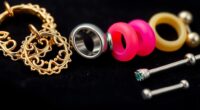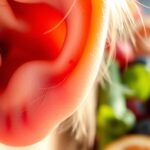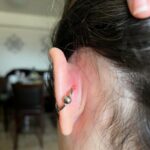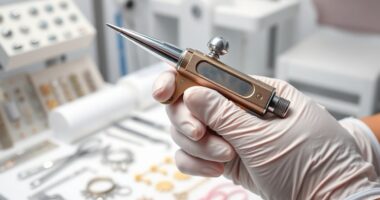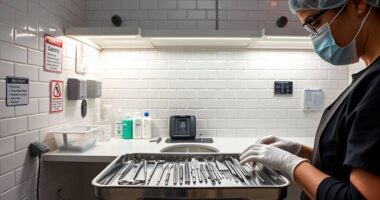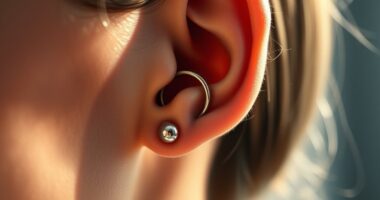When you get your skin pierced, you break the skin’s natural barrier, triggering a biological response. Blood rushes to the area, bringing immune cells like macrophages and neutrophils that clear debris and fight infection. Your body’s healing process involves inflammation, tissue formation, and remodeling, all controlled by immune activity and proper care. Using sterile techniques and good hygiene supports balanced healing, minimizing complications. To understand the detailed science behind this complex process, explore further.
Key Takeaways
- Piercing breaks the skin barrier, triggering blood vessel constriction and immune cell mobilization to prevent infection and initiate healing.
- Immune cells like macrophages and neutrophils clear debris and pathogens, supporting tissue repair and preventing complications.
- Healing occurs in three phases: inflammation, tissue formation, and remodeling, requiring proper immune regulation for optimal recovery.
- Proper aftercare maintains hygiene and minimizes trauma, ensuring immune responses facilitate effective healing and reduce infection risks.
- Sterile techniques and professional expertise help control immune activation, promote tissue regeneration, and improve healing outcomes.
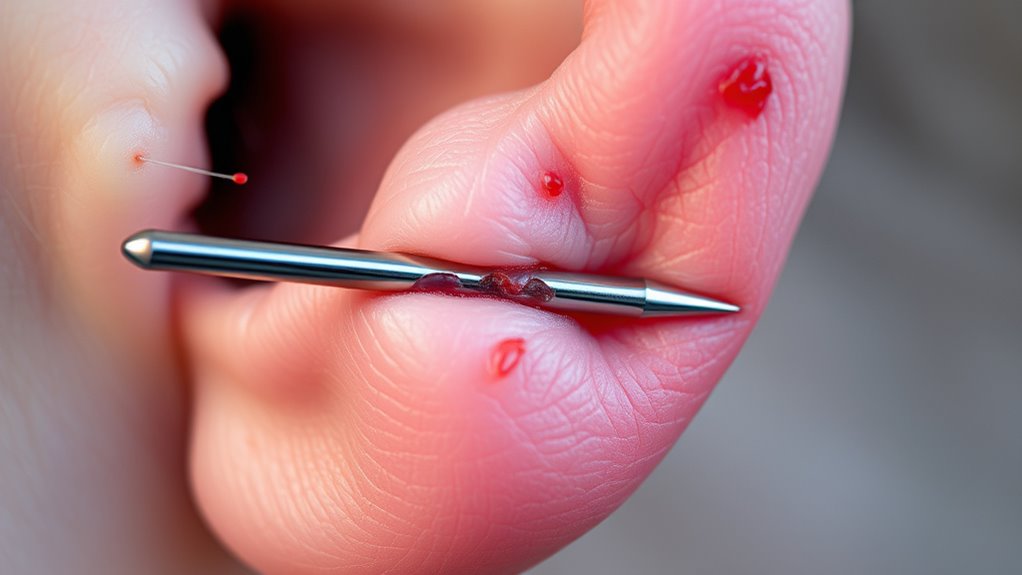
Skin piercing is more than just a body modification; it’s a complex science that combines biology, safety protocols, and technical skill. When you get pierced, your body responds immediately to the trauma. The tissue response involves a series of biological reactions designed to protect and repair. First, the skin’s natural barrier is broken, and blood vessels in the area constrict briefly to minimize bleeding. Once the needle or instrument passes through, blood rushes to the site, bringing essential nutrients and immune cells. This initial response is crucial for setting the stage for healing and preventing infection.
The body’s immune activation kicks in as a defense mechanism. Immune cells, such as macrophages and neutrophils, are rapidly mobilized to the injury site. These cells work to clear away debris and potential pathogens introduced during the piercing process. This immune response is vital because it determines how well your body handles the foreign object—like a jewelry piece—and influences how quickly the wound heals. A well-managed immune activation minimizes complications and promotes proper healing, but an overactive response can lead to excessive inflammation or scarring.
Understanding tissue response and immune activation helps you appreciate the importance of proper aftercare. Keeping the piercing clean and avoiding unnecessary trauma supports a controlled immune response, preventing complications like infections or excessive swelling. The tissue around the piercing will go through phases of inflammation, tissue formation, and remodeling. During the inflammatory phase, immune cells work tirelessly to prevent infection. In the subsequent tissue formation phase, new collagen and tissue develop to stabilize the piercing. Finally, during remodeling, the tissue strengthens and adapts to its new form.
Proper aftercare ensures healthy healing and prevents complications by supporting balanced immune responses and tissue regeneration.
Your body’s ability to effectively manage these processes hinges on your care and the environment you provide. Proper hygiene, avoiding irritants, and following professional advice ensure that immune activation remains balanced and tissue response is constructive rather than destructive. This delicate interplay between response and healing underscores the importance of choosing trained professionals who understand the anatomy and science behind skin piercing. They use sterile techniques to minimize immune activation beyond necessary levels, reducing risks and supporting optimal healing. Additionally, advances in biological understanding enhance the safety and success of piercing procedures.
Frequently Asked Questions
How Do Different Metals Affect Skin Healing After Piercing?
Different metals can impact your skin healing after a piercing through metal compatibility and allergic reactions. If you choose hypoallergenic metals like surgical steel or titanium, you’re less likely to experience allergic reactions, which can slow healing. On the other hand, nickel or other reactive metals may cause irritation or allergic responses, delaying recovery. Always opt for high-quality, compatible metals to promote quicker healing and reduce discomfort.
Can Piercing Damage Nerves or Blood Vessels Permanently?
You might think that piercing could be a shot in the dark, but nerve damage or blood vessel injury isn’t always permanent. If performed by a professional, the risk of lasting nerve damage or blood vessel injury is low, as they avoid critical structures. However, improper technique or trauma can cause lasting issues. Always choose a reputable piercer to minimize these risks and verify proper healing.
What Role Do Genetics Play in Skin Healing Response?
Genetic predispositions considerably influence your skin’s healing response. Your genes determine how quickly and effectively your body repairs itself, leading to healing variability among individuals. Some people naturally heal faster with minimal scarring, while others may experience slower healing or more prominent scars. Understanding your genetics can help you manage expectations and adopt appropriate aftercare to support ideal healing after piercing.
Are There Age-Related Differences in Healing Times for Piercings?
Think of your body as a garden where every age blooms differently. Age-related healing varies, with younger skin sprouting quickly and older skin taking longer to recover. As you age, healing time differences become noticeable, making piercings take more time to fully heal. You might find patience becomes your best friend, embracing the slower, wiser process that comes with age, ensuring your piercing heals beautifully and safely.
How Does Skin Type Influence the Risk of Infection?
Your skin type influences your risk of infection because certain skin susceptibilities, like oily or sensitive skin, can harbor bacteria more easily. If you have dry or resilient skin, you’re less prone to infections. To improve infection prevention, keep your piercing clean, avoid touching it with dirty hands, and follow aftercare instructions. Understanding your skin’s characteristics helps you take better precautions and reduce the chances of infection.
Conclusion
So, next time you poke a hole in your skin, remember you’re basically inviting a tiny army of cells and microbes to throw a party. With your body’s natural talent for healing, it’ll patch up the mess—probably faster than you can say “infection.” But hey, who needs flawless skin when you can have a permanent reminder of your rebellious spirit? Just don’t forget, every piercing is a tiny science experiment waiting to happen.
Piecing together a life one day at a time, that’s me. I’m Rusty, and I love being editor-in-chief of creative piercing. It’s my passion to help others see their vision and bring it to life. When I’m not working or taking care of my family, you can find me reading a good book or eating pie (of course!).


